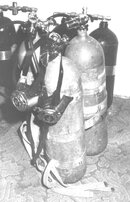elmer fudd
Contributor
I know they're rated at 1800 psi and folks used to use them for scuba back in the day. Why not now?
This link has 5 lb, (5" diameter X 17" tall), steel bottles for $50 each. The 10 lb. steel bottles measure 6"X22" and go for $55 each.
5 pound steel CO2 tank - Gehm & Sons, Inc.
That sounds to me like something that could be used to make an affordable set of triples. Is there a problem with the valve size on them or getting fills or what?
This link has 5 lb, (5" diameter X 17" tall), steel bottles for $50 each. The 10 lb. steel bottles measure 6"X22" and go for $55 each.
5 pound steel CO2 tank - Gehm & Sons, Inc.
That sounds to me like something that could be used to make an affordable set of triples. Is there a problem with the valve size on them or getting fills or what?





